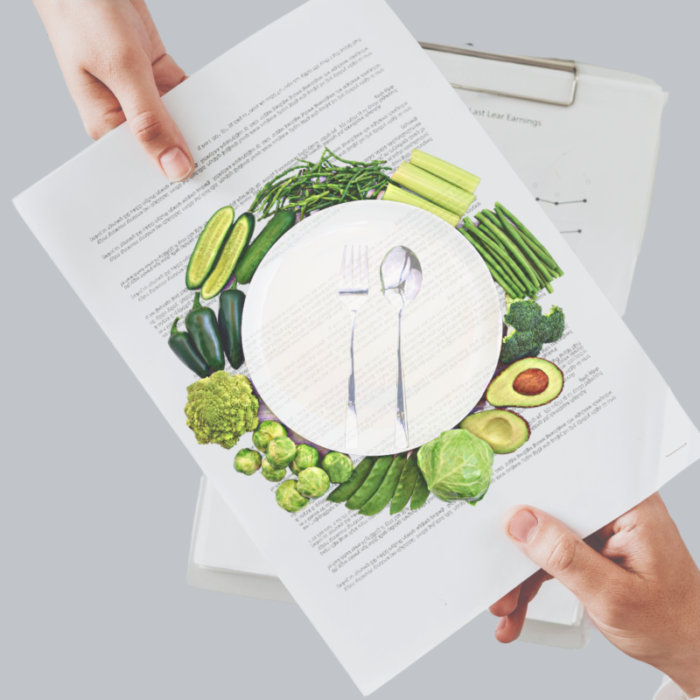
By Martin Liu
Edited By Courtney Schneider
Introduction
With a projected global population of 10 billion by 2050,1 countries face the difficult task of providing enough food to meet growing nutritional needs. Protein–a macronutrient vital to human health and development–is a key component of nutrition, with the Food and Agriculture Organization of the United Nations predicting that world meat production will double to meet growing demand.2 However, intensive animal agriculture has detrimental environmental and social effects that directly conflict with climate targets set by both the 2015 Paris Climate Agreement and the United Nations Sustainable Development Goals.3 Alternative modes of protein production are thus necessary to support global population growth while keeping greenhouse gas emissions low.4
Plants offer a promising source to meet this protein demand, either with minimally processed plant protein crops–such as beans, peas, nuts, and grains–or innovative, plant-based food products. Plant-based foods offer alternatives to meat, dairy, and eggs, all using plant protein ingredients that mimic existing animal-derived food products. These alternatives are gaining in popularity, with a market growth rate three times that of other foods5 and an increasing market share that may impact the long-run profitability of animal-derived foods. Although a rapid market shift and overall phaseout of animal agriculture would provide a quick, substantial reduction in greenhouse gas emissions,6 such a monumental change would also upend the 1 billion livelihoods that rely on animal agriculture.7 The transition must then be gradual, with effective policies put in place that equitably shift market supply and demand from animal-derived to plant-based proteins.8
Legislative actions and policy directives have set a precedent of federal support in American food production. Such support promotes public health, increases economic output, sustains agricultural ecology, and improves national security and resilience.9 The U.S. government has historically supported domestic agriculture in particular through the funding of research, development, and extension; establishment of market regulatory bodies; investment in agricultural infrastructure; and supplementing of farm incomes.10 The federal government has not, however, supported plant-based food production at levels comparable with the European Union, Singapore, and other countries.11 This shifted with the Biden Administration’s recent pledge to “increase the availability of…plant-based options” in federal facilities.12 Were the U.S. Executive Branch to implement such policy changes across federal agencies, plant-based diets would be promoted across the general population, supporting a growing food industry and ensuring the rights of everyday Americans to choose plant-based foods.
Updating the Dietary Guidelines for Americans, 2025-2030
Every five years, the U.S. government releases a new edition of its Dietary Guidelines for Americans with updated guidance on foods and food groups that promote a healthy diet. The federal government uses the Dietary Guidelines as the basis of its food and meal programs, nutrition education efforts, and decisions surrounding national health objectives.13 Recommendations in these guidelines have an outstanding impact on policies and programs administered at federal, state, and local levels.
The U.S. Department of Agriculture (USDA) and Department of Health and Human Services (HHS) play a key role in identifying topics to be reviewed for the Dietary Guidelines. These topics have historically included the same food groups and nutritional topics but ignored overall sustainability of the American diet.14 The Biden administration has repeatedly stated its intentions to reduce the environmental footprint of the global food system,15, 16 yet its leadership on the global stage has not yet been supported by action at the domestic level. In addition to considering the impacts of climate change on food security, the Biden administration should also call upon its Secretary of Agriculture and Human and Health Services to consider the carbon-intensive diets and foods that it recommends to the American people.17
The role and equivalence of plant-based protein foods should also be evaluated in the next iteration of the Dietary Guidelines. For example, the 2020 Dietary Guidelines for Americans failed to mention plant-based meats,18 despite being healthier than animal-derived meats.19 Plant-based milk alternatives were only briefly discussed, offering fortified soy milk as the sole recommendation for older children and adults.20 The base recommendation for dairy itself would benefit from reevaluation, as growing evidence proves milk unnecessary21 and possibly harmful22 to adult health. Similar recommendations to reduce meat consumption, eliminate the dairy category, and increase plant-based foods in the American diet have been issued by the Physicians Committee for Responsible Medicine.23
Once topics are identified for review, the USDA and HHS charter a Dietary Guidelines Advisory Committee to assess the latest scientific research on food, nutrition, and health. However, the scientific neutrality of the experts serving on the advisory committee has been questioned. A recent report determined that 95% of the committee members who served on the 2020 Dietary Guidelines Advisory Committee had direct conflicts of interest within the food or pharmaceutical industry.24 Major food companies and trade associations–including the American Egg Board, the Cattlemen’s Beef Board, and the National Pork Board–had direct relationships with multiple members of the advisory committee, including providing research funding, board seats, consulting jobs, honoraria, and awards. These relationships call into question the impartiality of committee recommendations to the Dietary Guidelines. Food industry actors have historically lobbied for entire food group recommendations such as dairy, grains, and meat.25 The USDA, whose primary responsibility is to support domestic agriculture, is inextricably linked to the food and agriculture industry and thus may not be the appropriate body to select unbiased advisory committee members.26 Instead, HHS–whose primary responsibility is to support medicine and public health–is better equipped to select an unbiased, balanced panel of health and nutrition experts to impartially advise the Dietary Guidelines.27
Agricultural Support and Food Distribution Programs
The USDA’s mission is to support domestic agriculture while also nourishing Americans, preserving the environment, and providing economic opportunities.28 Policies that prioritize plant proteins will achieve each of these goals.29 The House Sustainable Energy and Environment Coalition’s Climate and Agriculture Task Force recommended that the USDA provide financial incentives to small- and medium-sized farmers to cultivate plant protein crops,30 which could be administered through the Farm Service Agency via farm loans,31 price support, and insurance policies.32 The USDA Agricultural Marketing Service purchased more than $6 billion of domestically produced foods through its USDA Foods program in 2021,33 yet none of its current purchasing solicitations include any plant-based meat or dairy dairy/egg alternatives.34 This limits the variety of foods that the USDA can distribute in its food and nutrition programs. Amending USDA policies that incentivize plant protein crop cultivation and enable plant-based food distribution at the federal level would signal public investment in the plant protein industry. This shift to plant proteins could reduce food prices,35 strengthen food security,36 and create jobs.37
USDA-procured foods are distributed by the Food and Nutrition Service (FNS), which administers the National School Lunch Program (NSLP). If NSLP policies are amended, such distribution could also include plant-based foods. Since childhood nutrition is of utmost importance, NSLP requires schools to ensure that meat alternatives contain similar nutritional values as meat, but it does not currently offer any plant-based meat or egg alternatives.38 In addition, a serving of legumes can be credited as either a meat equivalent or a vegetable but not both,39 despite being a nutrient-dense source of both protein and fiber. Requiring food-service products to include child nutrition labels would reduce a major barrier for school meal planners to incorporate plant-based meats into their menus.40 FNS could also restructure meal reimbursement rates that incentivize plant-based foods, modeled after a recent bill passed by the California State Assembly which reimburses school districts for each plant-based meal or milk alternative served to students.41 These policy changes would enable and incentivize school administrators to provide more of such meals.
Ensuring the Religious Rights of Americans
Several federal agencies operate in contexts where they are the sole purchaser, distributor, and provider of foods. The U.S. Department of Defense (DOD) commands domestic facilities and procures military rations that sustain American soldiers across the globe. The DOD, HHS, and the U.S. Department of Veterans Affairs (VA) together operate hundreds of federal hospitals that feed thousands of patients annually. The U.S. Department of Justice (DOJ) Federal Bureau of Prisons feeds hundreds of thousands of incarcerated individuals each day. Thus, as a service member, patient, or inmate, an individual’s food choice is limited to the options provided by the government.
Availability of plant-based options at federal facilities is extremely variable. A recent survey reported that all federal prisons provided plant-based options at every meal, but only half of DOD facilities and three-quarters of VA hospitals offer plant-based meals at least three times a week.42 Additionally, deployed military service members do not have access to vegan Meals Ready-To-Eat (MREs),43 although the 2023 National Defense Authorization Act includes a pilot program that will evaluate the feasibility of procuring plant-based MREs in forward operating Navy bases.44
To uphold citizens’ rights to freedom of religion, federal agencies should provide kosher, halal, vegetarian, and vegan meals compliant with religious diets. This right has been and is continually fought for in federal prisons45 on grounds of First and Eighth Amendment rights,46 but the same has not occurred across other federal agencies. Some schools, hospitals, and DOD facilities provide meat-containing kosher and halal meals, yet these often cost more than the standard meal, raising concerns about potential conflicts with the U.S. Constitution’s Establishment and Equal Protection Clauses.47 Since most plant-based meats are certified kosher,48 halal,49 vegetarian, and vegan, the procurement and preparation of plant-based meals in federal facilities can simplify operations, reduce costs, and ensure the religious rights of Americans.
Conclusion
With a precedent of assisting food and agriculture industries, the U.S. government should extend a similar level of support to the plant-based foods industry. Adjustments to federal agency policies to promote and prioritize plant-based foods will have a meaningful effect on improving human health, supporting a growing food industry, and observing the rights of American citizens. Changes to the USDA and HHS methodology for preparing the Dietary Guidelines for Americans, such as including sustainability metrics, evaluating plant-based alternative foods, and minimizing advisory committee conflicts of interest, will result in a fairer set of nutrition recommendations. The USDA can make specific policy changes that incentivize the cultivation of plant protein crops, amend purchasing guidelines to enable plant-based food distribution, and remove barriers to adopting plant-based meals in school lunch programs. Expanding plant-based food options in federal facilities across the DOD, HHS, and VA would uphold the religious rights of Americans. These gradual changes across multiple federal agencies can have broad implications for the American food system as a whole, aligning with both market trends and climate goals. The U.S. government could lead by example through transitioning its domestic food policies toward a more sustainable path and demonstrating its capacity to feed a growing population on a changing planet.
Endnotes
- “World Population Projected to Reach 9.8 Billion in 2050, and 11.2 Billion in 2100,” United Nations Department of Economic and Social Affairs, June 21, 2017, https://www.un.org/development/desa/en/news/population/world-population-prospects-2017.html.
- Livestock’s Long Shadow (Food and Agriculture Organization of the United Nations, 2006), https://www.fao.org/3/a0701e/a0701e.pdf.
- Lisa Sweet, “How Can We Produce Enough Protein to Feed 10 Billion People?,” World Economic Forum, January 14, 2019, https://www.weforum.org/agenda/2019/01/how-can-we-produce-enough-protein-to-feed-10-billion-people/.
- Julie Guthman et al., “In the Name of Protein,” Nature Food 3, no. 6 (June 2022): 391–93, https://doi.org/10.1038/s43016-022-00532-9.
- Emma Ignaszewski, “2021 U.S. Retail Market Insights Plant-Based Foods” (Good Food Institute, 2022), https://gfi.org/wp-content/uploads/2022/10/2021-U.S.-retail-market-insights_Plant-based-foods_GFI-1.pdf.
- Michael B. Eisen and Patrick O. Brown, “Rapid Global Phaseout of Animal Agriculture Has the Potential to Stabilize Greenhouse Gas Levels for 30 Years and Offset 68 Percent of CO2 Emissions This Century,” PLOS Climate 1, no. 2 (February 1, 2022): e0000010, https://doi.org/10.1371/journal.pclm.0000010.
- Antonio Rota, “How to Do Livestock Value Chain Analysis and Project Development” (International Fund for Agricultural Development, January 2016), https://www.ifad.org/documents/38714170/40262483/Livestock+value+chain+analysis+and+project+development.pdf.
- Charlotte Blattner, “Just Transition for Agriculture? A Critical Step in Tackling Climate Change,” Journal of Agriculture, Food Systems, and Community Development 9, no. 3 (March 25, 2020): 53–58, https://doi.org/10.5304/jafscd.2020.093.006.
- Sidonie Devarenne and Bailey DeSimone, “History of the United States Farm Bill,” Library of Congress, accessed December 8, 2022, https://www.loc.gov/ghe/cascade/index.html?appid=1821e70c01de48ae899a7ff708d6ad8b&bookmark=Farm%20Bills.
- Anne Effland, “U.S. Farm Policy: The First 200 Years” (Agricultural Outlook, 2000), https://www.ers.usda.gov/media/fregl5ap/us-farm-policy_the-first-200-years.pdf?locale=en.
- “The United States Should Prioritize Public Investment in Alternative Proteins” (Good Food Institute, n.d.), https://gfi.org/wp-content/uploads/2021/01/GFI-Open-Access-Research-Fact-Sheet-2022.pdf.
- “Biden-Harris Administration National Strategy on Hunger, Nutrition, and Health” (The White House, September 2022), https://www.whitehouse.gov/wp-content/uploads/2022/09/White-House-National-Strategy-on-Hunger-Nutrition-and-Health-FINAL.pdf.
- “History of the Dietary Guidelines,” Dietary Guidelines for Americans, accessed November 9, 2022, https://www.dietaryguidelines.gov/about-dietary-guidelines/history-dietary-guidelines.
- Amy Roeder, “Eat Greener: A Call for Sustainability in U.S. Dietary Guidelines,” Harvard T.H. Chan School of Public Health, November 25, 2019, https://www.hsph.harvard.edu/news/features/eat-greener-sustainability-dietary-guidelines/.
- “Background on the U.S. Approach to the 2021 UN Food Systems Summit” (United States Department of Agriculture, August 4, 2021), https://www.usda.gov/sites/default/files/documents/Background-on-US-approach-2021-UN-Food-Systems-Summit.pdf.
- “FACT SHEET: President Biden’s Leadership to Tackle the Climate Crisis at Home and Abroad Galvanizes Unprecedented Momentum at Start of U.N. Climate Conference (COP27),” The White House, November 7, 2022, https://www.whitehouse.gov/briefing-room/statements-releases/2022/11/07/fact-sheet-president-bidens-leadership-to-tackle-the-climate-crisis-at-home-and-abroad-galvanizes-unprecedented-momentum-at-start-of-u-n-climate-conference-cop27/.
- Roeder, “Eat Greener: A Call for Sustainability in U.S. Dietary Guidelines.”
- U.S. Department of Agriculture and U.S. Department of Health and Human Services, Dietary Guidelines for Americans, 2020-2025, 9th ed., 2020, https://www.dietaryguidelines.gov/sites/default/files/2021-03/Dietary_Guidelines_for_Americans-2020-2025.pdf.
- Christopher J. Bryant, “Plant-Based Animal Product Alternatives Are Healthier and More Environmentally Sustainable than Animal Products,” Future Foods 6 (December 2022): 100174, https://doi.org/10.1016/j.fufo.2022.100174.
- U.S. Department of Agriculture and U.S. Department of Health and Human Services, Dietary Guidelines for Americans, 2020-2025, 9th ed., 2020, https://www.dietaryguidelines.gov/sites/default/files/2021-03/Dietary_Guidelines_for_Americans-2020-2025.pdf.
- “Milk Not Necessary for Adults, Can Be Good Option for Kids,” Harvard T.H. Chan School of Public Health, December 3, 2019, https://www.hsph.harvard.edu/news/hsph-in-the-news/milk-health-adults-kids/.
- “Health Concerns About Dairy,” Physicians Committee for Responsible Medicine, accessed November 9, 2022, https://www.pcrm.org/good-nutrition/nutrition-information/health-concerns-about-dairy.
- “2020-2025 Dietary Guidelines for Americans Recommendations,” Physicians Committee for Responsible Medicine, accessed December 8, 2022, https://www.pcrm.org/good-nutrition/nutrition-programs-policies/2020-2025-dietary-guidelines.
- Mélissa Mialon et al., “Conflicts of Interest for Members of the U.S. 2020 Dietary Guidelines Advisory Committee,” Public Health Nutrition, March 21, 2022, 28, https://doi.org/10.1017/S1368980022000672.
- Marion Nestle, Food Politics: How the Food Industry Influences Nutrition and Health, 1st ed., California Studies in Food and Culture (University of California Press, 2013), https://www.jstor.org/stable/10.1525/j.ctt7zw29z.
- Madison Wonson, “Conflicts of Interest in Nutrition Policy” (Virginia State Bar, n.d.), https://www.vsb.org/docs/sections/adminlaw/Wonson_Conflicts_of_Interest_in_Nutrition_Policy.pdf.
- Wonson.
- “About the U.S. Department of Agriculture,” U.S. Department of Agriculture, accessed October 21, 2022, https://www.usda.gov/our-agency/about-usda.
- Ariel Ron and Alex Smith, “American National Competitiveness and the Future of Meat,” The Breakthrough Institute, June 14, 2022, https://thebreakthrough.org/articles/american-national-competitiveness-and-the-future-of-meat.
- Chellie Pingree et al., “Recommendations for a Climate-Friendly Farm Bill,” November 16, 2022, https://seec-tonko.house.gov/sites/sustainableenergyandenvironmentcoalitioncaucus.house.gov/files/documents/22.11.16%20SEEC%20Climate%20%26%20Ag%20TF%20Report.pdf.
- “Farm Loan Programs,” U.S. Department of Agriculture Farm Service Agency, accessed December 8, 2022, https://fsa.usda.gov/about-fsa/structure-and-organization/farm-loans/index.
- “Farm Programs,” U.S. Department of Agriculture Farm Service Agency, accessed December 8, 2022, https://fsa.usda.gov/about-fsa/structure-and-organization/farm-programs/index.
- “Fiscal Year AMS Purchases by Vendor,” Agricultural Marketing Service, accessed October 21, 2022, https://www.ams.usda.gov/reports/fiscal-year-ams-purchase-summaries.
- “Purchase Programs: Solicitations & Awards,” Agricultural Marketing Service, accessed October 21, 2022, https://www.ams.usda.gov/selling-food/solicitations.
- Nigel Purvis and Bruce Friedrich, “Plant-Based Proteins Are Too Expensive,” Foreign Policy, October 8, 2022, https://foreignpolicy.com/2022/10/08/alternative-protein-meat-agriculture-food-security-plant-based-environment/.
- “Why the United States Should Champion Alternative Proteins As A Food and National Security Solution” (Climate Advisers, October 2022), https://gfi.org/wp-content/uploads/2022/10/Climate-Advisers-GFI_Alternative-Proteins-Food-and-National-Security.pdf.
- “Why the United States Should Champion Alternative Proteins As A Food and National Security Solution.”
- “USDA Foods Available List for School Year 2022-2023 for Schools and Institutions” (Food and Nutrition Service, December 2021), https://fns-prod.azureedge.us/sites/default/files/resource-files/usdafoods-available-list-sy22-23.pdf.
- “Food Buying Guide for Child Nutrition Programs” (U.S. Department of Agriculture Food and Nutrition Service, n.d.), https://foodbuyingguide.fns.usda.gov/Appendix/DownLoadFBG.
- “Requirements for Alternative Protein Products in the National School Lunch Program and School Breakfast Program” (Connecticut State Department of Education, October 2022), https://portal.ct.gov/-/media/SDE/Nutrition/NSLP/Crediting/APP_Requirements_SNP.pdf.
- Steve Holt, “Vegan Fridays for All? More Schools Offer Plant-Based Meals,” Civil Eats, March 21, 2022, https://civileats.com/2022/03/21/vegan-fridays-for-all-more-schools-offer-plant-based-meals/.
- Julia Martiner and Geoff Horsfield, “Federal Facilities Should Offer More Plant-Based or Vegetarian Options,” Environmental Working Group, August 30, 2022, https://www.ewg.org/news-insights/news/2022/08/federal-facilities-should-offer-more-plant-based-or-vegetarian-options.
- Rachel Krantz, “Green Zone: The US Soldiers Fighting for Vegan Food,” The Guardian, February 26, 2019, sec. US news, https://www.theguardian.com/us-news/2019/feb/26/us-military-vegan-plant-based-food-mres.
- Adam Smith, “H.R.7900 – National Defense Authorization Act for Fiscal Year 2023,” Pub. L. No. H.R.7900, § 222 (2022), https://www.congress.gov/bill/117th-congress/house-bill/7900/text.
- Bernard J. Farber, “Prisoner Diet Legal Issues,” AELE Monthly Law Journal 7, no. 301 (July 2007), https://www.aele.org/law/2007JBJUL/2007-07MLJ301.pdf.
- Jane McElligott, “Legal Rights of Inmates to Practice Veganism” (Purdue Global University, December 10, 2019), https://isb.idaho.gov/wp-content/uploads/ANM-Section-Meeting-Materials-Dec.-10-2019.pdf.
- Johanna Markind, “Federal Government Subsidizes Halal Food in Public Schools,” Islamist Watch (blog), August 28, 2015, https://www.meforum.org/islamist-watch/47153/federal-government-subsidizes-halal-food-in.
- Steven Genack, “Kosher Plant-Based Foods Is a Natural Combination,” OU Kosher, April 28, 2021, https://oukosher.org/blog/news/kosher-plant-based-foods/.
- Rosa Safitri, “Are Vegan and Vegetarian Foods Always Halal? – Here’s What You Need to Know,” Halal Guidance (blog), accessed November 10, 2022, https://halalguidance.com/are-vegan-and-vegetarian-foods-always-halal-heres-what-you-need-to-know/, https://halalguidance.com/are-vegan-and-vegetarian-foods-always-halal-heres-what-you-need-to-know/.





